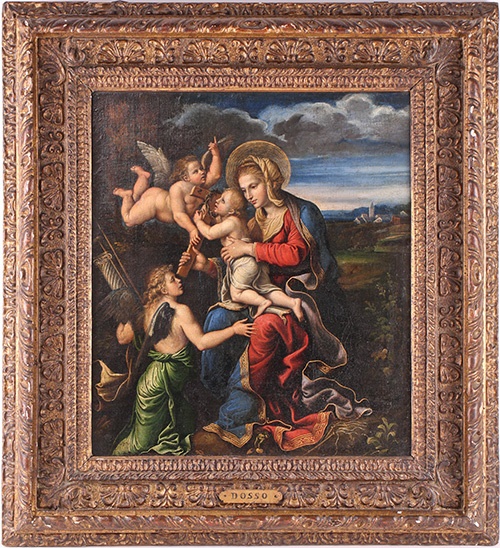How paintings are valued
Find out how we value your art
03/10/2022
There are multiple factors to consider when determining a painting’s value, and our team of painting specialists here at Dawsons, are highly experienced in valuing paintings across many different genres, periods and artistic movements.
Art valuation is a subjective process that ultimately relies upon a valuer’s own judgement and professional expertise. Whilst estimates can vary slightly from one valuer to the next, at Dawsons, we pride ourselves on consistency. We regularly monitor the global art market and carefully carry out our valuations accordingly based on a number of factors including provenance, condition, subject matter, desirability and past auction results.
Here, we share with you the key areas of focus when it comes to valuing any painting.
Follower of Filippino Lippi (1457-1504), a depiction of the Madonna and Child with attendant angels
Artist
When a valuer is presented with a painting, the first thing they will look at is the artist who produced the work. The reason for this is that the name of the artist will often offer the first indication of a painting’s value, without so much as having to glance at the piece itself.
Another important factor is whether a painting is an original piece, or a print. Brush strokes and textural contrasts on the surface are usually common indicators that a piece is an original. However, if your painting is a print, don’t let it put you off selling. Signed limited editions by a well-established artist can prove extremely popular at auction.
Tristram Hillier RA (1905-1983), a still life study, 'Apples & Peaches with a Tin Jug'
Rarity and Quality
As any valuer will know, the rarity of an object is a defining feature when it comes to understanding its value. In a classic case of supply and demand, when there is a limited selection of items on the market, they become more desirable, and their value subsequently drives up.
Age alone does not define value, but rather it needs to be coupled with skilful demonstrations of artistry. If you are in possession of an old piece of art held within a frame, it is important you do not attempt to remove the frame as this can devalue the painting. A frame can add to a painting’s value if it is an original; this is particularly the case with oil paintings. Perhaps the most important factor is subject matter and desirability, a sought-after subject matter by a lesser-known artist will sometimes make more than a less-desirable subject matter by a well-known artist.
B Prabha (1933-2001) Indian, half-length portrait of a woman
Provenance
This term refers to both a piece’s origin and history of ownership. Whilst ownership does not tend to add value, it can help to predict the sale value of an item. For example, if a painting comes from an established collector or private owner, there is more guarantee that the piece is genuine and may also be considered rarer as it has not been seen on the market recently.
However, in some circumstances, provenance can add to a painting’s value if there is a history of relevant ownership. This is usually the case if the owner is or was famous, connected to a well-known institution, or had a significant historical background.
Horace Van Ruith (1839-1923) British/German, 'Malabar Point, Bombay'
Condition
The condition of a painting can either be extremely beneficial or detrimental to its value. However, whilst good condition is generally preferred for paintings, buyers sometimes choose to pay more for a rare piece in poorer condition than one less rare and in excellent condition.
Past sale results
Considering the sale results of comparable paintings from previous auctions, is an extremely helpful way for a valuer to make realistic auction estimates for future sales. Our team of valuers use dedicated price databases, so we can track the success of past items and identify patterns in the market that might influence the value of current sale items. The art market is constantly changing, which is why we believe that recognising past trends, as well as current, is the best way to predict future activity and provide well-informed, realistic auction estimates for our clients.
Do you have a painting you are looking to sell?
Our team of expert art valuers are always happy to help you determine the value of your artwork.
We offer a complimentary valuation service and can also provide insurance valuations where required.
Get in touch with us today, we would love to hear from you.
0207 431 9445 / info@DawsonsAuctions.co.uk



